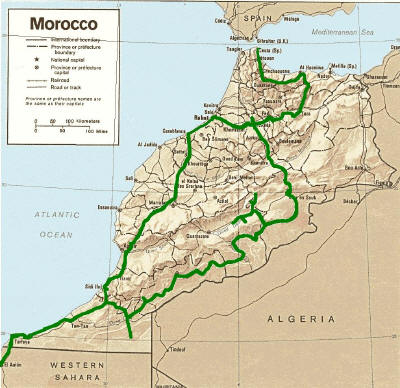
Friday 4 to Sunday 6 November 2011, Tatouane
We left the hard rain and hail behind, but it is still raining. The ferry is amazingly fast now-a-days. Last time (23 years ago) it took 1.5 hours. This time only .5 hour. Of course you have to add extra for leaving late and other delays to both times. Ceuta was extremely congested because of the arrival of the ferry. We went off the wrong way and ended up doing a small tour of the enclave. Eventually we headed for Marruecos, Morocco in Spanish. The border was reasonably smooth and relatively fast, just over half an hour. There were touts everywhere trying to tell us that the border was difficult and offering their services. We refused them all but ended up with an official (he had an id card) who insisted on helping us. He was disappointed when we did not give a tip. Actually I found him annoying. Maybe if it is the first time some-one has been through a normal road border they need help to understand what needs to be done and why. After all Europe has no borders and Eastern Europe is often just a passport check.
Once through the border we headed down the coast to a campsite in the hope that the weather would improve in a day or two.
I have noticed that there are signs in Arabic and Western lettering but numbers are always Western. They do not use the Arabic numbers at all except occasionally by an individual doing sums on scrap paper.
Once we had set up camp the air raid siren went off very near by. What now? Eventually we heard the 'akbah' and realized it was the call to prayer. We did more or less get used to it, but OH for a more gentle call! The weather did improve and after a day in the sun it was time to move on.
Monday 7 to Tuesday 8 November 2011, Al Hoceima
Where are all the people? There was no-one around. The shops were closed. There was an occasional group of young men but very few cars. Surely this is not normal? At Chefchauen we tried to buy bread only to be told that there was none in the whole of the town. Another man explained that is was Eid, the festival at the end of Ramadan. No wonder!
The Rough Guide described the route to Al Hoceima as maybe one of the highlights of a visit to Morocco. It is certainly scenic going through the Rif Mountains, which are very gentle, and pine forests. A highlight? I hope not! Running water is not available. We saw several men carrying water in containers sitting side saddle on donkeys. One day I will get a photo. The route goes through the major cannabis growing region. There were several offers to come to eat and smoke. Pieter has never tried it but I have and it makes me sick, so we declined. Pieter was also quite suspicious. Later I read that if you accept you are likely to be robbed. And here I was thinking it had to do with Eid! After 300k of winding roads we were both ready to stop. The Plage Izly near Al Hoceima was the perfect place. Very few people and right on the beach. A day here and Eid will be over.
Wednesday 9 November 2011, Taza
There is bread but many businesses are still closed. The streets are layered in rubbish. It is just thrown away. There are also places where piles of rubbish are just left. Ours joined them.
We had a lovely wash in Taza. I have never been to an Hammam before and had to be shown the routine. First undress (there are separate facilities for men and women), then go into the first room to collect 4 buckets. In the main room fill the buckets with hot and cold water, find a place on the floor and start washing using a scoop to take out the water. I have never seen so much water being used to bathe. It is less than a full bath though. Some of the women kept their underpants on but most didn't. Pieter said that ALL the men kept their undies on. Prudes!
Tonight we are wild camping in the Djebel Tazzeka Nature Reserve listening to the birds. Unfortunately there are not very many, presumably they have all gone south for winter. Two mixed herds of sheep and goats passed by. The herders hit the branches of the cork oaks to release leaves and acorns which the animals ate. They were quite friendly.
Moroccans seem generally not to be fanatical about religion. The exception being that non-believers are not allowed to enter a mosque. Many women do not wear headscarves and younger ones wear tight fitting clothes, even when they are long straight dresses.
Thursday 10 to Thursday 17 November 2011, Fez
The Fez International camp ground has no sign boards to show where it is. At least being next to the football stadium on the Sefrou road made it easy to find. It must have been built 3 or 4 years ago but no repairs have been done since. Still there is electricity, water and wifi. The weather is hot and sunny, perfect for a day relaxing in the heat before tackling the medina.

There are 3 medina right next to each other. Together
they are large. We had been asked several times at the camp ground if we wanted
a guide but had refused. We still ended up with an unofficial guide though.
It happened this way. We were given general directions to the medina and
followed these successfully. Unfortunately the various maps show the new town
and the medina but not the connection between the two. Eventually after driving
through and around the medina we parked. We were approached and I asked where we
were,
as
we had no idea. We were told Mellah, the old Jewish quarter. Again the maps did
not tie this up for us. We walked off but were of course followed by our
friendly unofficial guide. In the end we engaged his
services. He showed us the Jewish quarter, which is not very interesting and
a panoramic view of the medina. The shopping then started. First stop was a
pottery where they make mosaics and general pottery items. The making of the
mosaics was very interesting. First tiles are made by the usual method, firing,
glazing, firing again. The patterns for small pieces are then marked on the
tiles. The next artisan chips away at the tile to ensure a straight edge and
perfect corners. Artisan number 3 bevels the pieces, in other words he chips
away at the underside. Next artisan takes the tiles and places them upside down
on the floor or other flat surface, fitting them together perfectly. He finishes
the work by pouring concrete over the this lot. Once it is dry, turn it over and
you have a beautiful mosaic. This was then turned into a table, wall
decoration or whatever it was designed for. To think that all this work has gone
into the decoration of millions of mosques, public buildings and homes.
Fantastic.
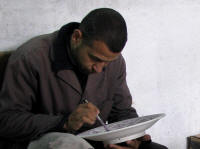
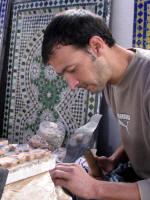
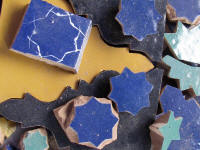
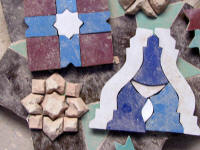
We also visited a herbalist, a carpet shop and a very expensive restaurant where we had one lunch between the two of us. The one very good thing Arab-Hassan did though was to take us to a mechanic who fixed the exhaust. The welding had been done back in Croatia but there was a terrible rattle when idling. He removed lots of rusted and broken pieces from the inside of the exhaust and the rattle has gone. Will it last? Time will tell.
We went back to the Medina the next day. This time we knew how to get to the area we wanted because we had been shown the map in the Lonely Planet. Praise be on the LP. We parked in the appropriate place along with many other tourists and promptly went into an enclosed area. A young boy showed us out and onto the correct path, for a small consideration. He was quite eager to stay with us but we made it clear we were not interested and he eventually gave up. This was much more like what we had expected. Narrow streets with small shops on both sides and many people. We love walking through areas like this and as long as you stay near the two main arteries you are fine. There are two experiences which stand out, the tannery and coffee. Coffee was taken in a tourist cafe, this time of our choosing. The coffee was delicious but the little cakes we had with it were to die for. We found some later and bought them. They went before bed-time.
The tannery was very interesting. Dead wool is first scraped off the hide. Dead wool? Live wool comes from live sheep and is used to make clothing. Dead wool comes off dead sheep and is used as stuffing in pillows etc. Apparently it is not suitable for spinning. The hides are then soaked in ammonia and pigeon shit to soften them. This stinks but we were given some mint when we entered the tannery and this helped. They are washed and any leftover wool removed before being placed in dying vats. Yellow is the most expensive as it is made using saffron. Watching the operation was fascinating. Naturally the shop came next. The leather for the coats was lovely and soft, I was sorely tempted.
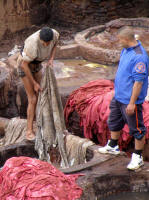
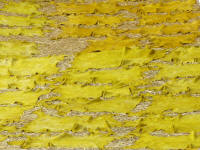
We visited another herbalist on the advice of the tannery man. He claimed that Argon oil and cream would remove the bags under Pieter's eyes. Prices were three times as much as the previous herbalist but we cut it down substantially. Now we will see in a few months time if it actually works. There was very little hassling by guides and young boys though they were always around ready to take up any opportunity. The shop owners did not hard sell either. The Moroccans are much more friendly and a lot less pushy than the Egyptians.
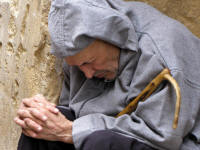
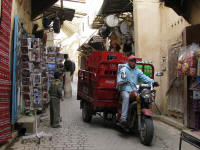
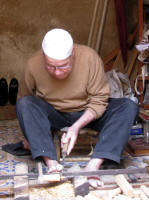
Friday 18 to Monday 21 November 2011, to Todra Gorge
Volubilis, near Meknes was Rome's remote capital to the south west. The city was built on an older Berber city. Rome could not subdue the Berber tribes and left after 2 centuries. In the mean time they had sent all the Barbary Lions to Rome for sacrifices. It is a large site with quite a few mosaics on view. These have been faded by the sun but are still in good condition.
We had intended to spend some time in Meknes but it was cold and raining so we moved south instead, missing a few places on the way. We stopped in the High Atlas for the night. The next day we had every kind of weather. We woke up to zero temperatures (yea, we have a heater), it snowed through the High Atlas at 2,000m, there was wet snow lower down, followed by rain, then dry cloudy weather and finally sunshine. Once it was dry we started looking for a place to camp. We followed a track between ridges into a valley with a large shallow pool in the centre. It was far too windy and cold though so we backtracked only to be waylaid by a souvenir seller. He had been on his way to us. Obviously he saw us leave the road. You are never alone, even in the wilderness.
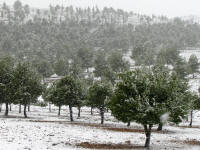
Tuesday 22 to Thursday 24 November 2011, Todra and Dades Gorges
A three day saga of backtracking, accidents, cold and some great moments. A period which was difficult and frustrating but will be remembered as a great adventure.
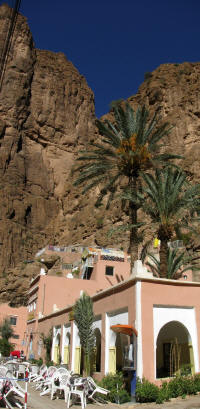
Todra Gorge is impressive and touristy. It is narrow with the sides going up many meters. We continued north to Agoudal and then turned south along a dirt road to Dades Gorge. It was a rough track and we came across some riders returning home who told us the route was closed due to snow. We waited until they were well past as the mules did not take kindly to the sound of the engine, then we turned around. But they had stopped. After waiting a while we realized that one man was lying on the ground. We approached carefully because of the mules. He had been kicked in the face by a mule and was covered in blood. I cleaned his face to see what the damage actually was. The water was warm from the heat of the car. It would have been worse for him if the water had been icy. He had a very nasty gash just above his eye plus other cuts. He was loaded into our car. He wasn't really capable of getting himself in without help. He must have had a terrible headache on top of everything else. We took him to a dispensary where a nurse could attend to him. By this time the whole of Agoudal knew he was injured, including his wife. The dispensary was opposite a hotel with camping, so we stayed the night.
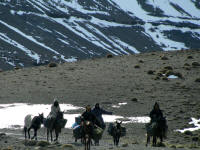
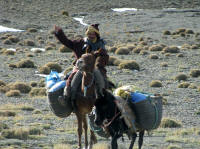
The lounge area was lovely and warm. Once it started snowing we stayed there until bedtime. Dinner was couscous and chicken. No way was Pieter cooking in the snow. The nurse came around to meet his friends and told us he had sent the patient through to the doctor in Imilchil for stitches. The owner also informed us that Agoudal is the highest village in Morocco! At least we were warm during the night and the heater was a marvel in the morning.
We still wanted to go through Dades Gorge from the north so we headed south to Ait Hani and turned west along another rough track. We came across a campground far from everywhere and asked about the condition of the road ahead. We were told that a car similar to ours had come through yesterday. Reassured we went on. The scenery was magnificent. The road goes over limestone, through a pass and then up the Tizgui n'Ouaddou Valley. There are several Berber families living in caves along the valley and one encampment with 2 tents covered in snow. The snow enhanced the view tremendously. It also started snowing, gently at first and then heavier and heavier. The road itself was not always obvious but we had the tracks from yesterday's vehicle to follow. Then it started going up and the snow became thicker and thicker and thicker until eventually we dug ourselves in! By this time the front wheels were more than halfway submerged. YES we should have turned back earlier but we didn't. The sand ladders came off, the snow was dug away, the car was reversed and pointed east. It was actually quite scary as the road is narrow and the sides sloping. The car slipped a few times. At least I was outside to help if something happened to Pieter.
Once again we backtracked. This time we had no option but to return to the bottom of Todra Gorge. We stayed the night in Tenerhir in a very windy camp ground.
Next morning it was raining. Not the type of day to go
though a scenic gorge. This time we decided to stay on the main roads and head
for Zagora. The roads were awash with muddy water. The cars moved slowly and the
pedestrians did their best to stay clear of the spray. Some cars were very
hesitant to go through the water and they stayed to the side of the road.
Eventually we came to a long queue of cars. I walked up to find out what was
happening. The road was definitely awash with fast moving water. There were
buses and trucks in the queue. The drivers were also looking at the bridge and
the water rushing over it. If they didn't want to go over then maybe we
shouldn't either. Pieter had a look and agreed. We also looked north where the
river came from and all we could see was lots of rain still pouring down. I
don't know what everyone was waiting for but we decided to ---- that's right ---
backtrack.
There were two roads we could take. One was the road we
had come up on on Tuesday and the other was closer but over a 2,000 meter pass.
I felt we should give the pass a miss as there was sure to be snow. Pieter
wanted to give it a try. It went well until we started to climb. First the rain
turned to wet snow then dry snow and more and more came down. Still Pieter went
on. Trucks and cars started to come towards us. We stopped one and asked about
the pass. It was blocked by snow and they were all returning with the intention
of following another road. Again we turned around. This time we backtracked all
the way almost to our starting point on Tuesday.
We couldn't find a signposted campground in Tazzarine so we camped in the desert and watched the sunset. The sky in the north still looked as if it was raining and snowing.
Friday 25 to Tuesday 29 November 2011, Zagora
What a laid back place this is. A great place to rest and catch up on all those domestic chores. This included having the exhaust fixed - again! This time they opened it up and found that the damper had broken off at one end. This is what was causing the rattle. Most of the damper was removed along with all the padding and welded together again. Pieter said that wouldn't matter. The car is almost as quiet as it used to be with the damper.
NB. Later it started to rattle again, obviously the rest of the damper should have been removed.
The market was interesting. Goods for sale ranged from household ware, clothes, vegetables and spices. As elsewhere small portions of saffron are for sale at greatly reduced prices compared to Europe. The people are mainly Berber. Both men and women wear the traditional galibaya(?) with the hood down the back. Men wear turbans and women wear a long piece of cloth in a similar way to a sari. The colour of the people ranges from dark European to black but the majority have the wide noses needed in a hot climate. There is lots of clothing underneath as well against the cold. As in the rest of Morocco the houses are painted in mud colours, salmon, peach, yellow and yellow-brown, or left as is if the walls are made of mud brick. They blend with the country side.
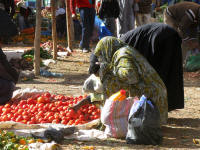
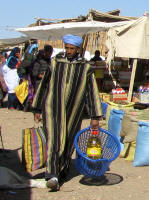
And everywhere there is electioneering. We have been caught up in the convoys of cars, buses and trucks numerous times. There can be fifty cars and trucks in one convoy. They go slowly through towns using a loud speaker to talk to the people. They also throw out handbills. You know they have been through because of the litter! The only people with any use for the handbills seems to be the children. At least before and after the town they stop to allow the convoy to regroup. That is when other cars like us can get past easily.
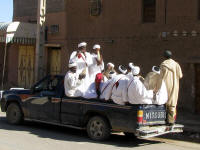
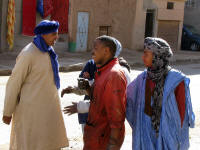
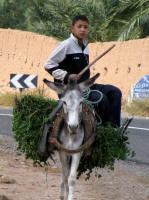
Wednesday 30 November 2011, Akka
The road between Zagora and Foum-Zguid is unpaved but the basics are there. It has been built up, drains put in under the road and smoothed nicely. Until that is the rains came down and washed huge chunks out of the road. Detours are common. Towards the middle of the route the road goes through a river bed several kilometers wide. Here nothing has been done. You have to go over large bumps and more or less make your own way through the extremely rough scree. Amazingly communal taxis go along the route. Passengers are dropped of at the occasional house or nomad tent. Considering how dry the area is there are quite a number of people living there. Water is available every now and then. Holes have been bored down into the underground water and pumps installed with troughs for the goats. They make good places for washing clothes as well.
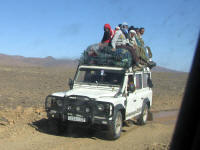
Thursday 1 December 2011, Tadalt
We deiced to take the southern route through the desert to Layonne. We expected it to take a few days to go through a relatively uninhabited area. At Zag we had a surprise. The police informed us that we could not go further as it was a military zone. We couldn't even take another dirt road from Zag to Tan Tan. Very disappointed we had to turn back. Yes! Again! Curses!
Friday 2 to Thursday 15 December 2011, heading south
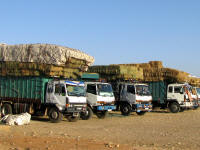
Unfortunately very little money came through this month. We stayed on the beach near Tan Tan for several days. It was windy and initially at least warm. When it became colder we moved down to Laayoune. It was still windy but much warmer.
Campers had stopped at several places along the coast until the National Park north of Tarfaya. Line fishermen were everywhere. There are groups of 1 or 2 houses along the coast and I assume they eat the catch. Fishing boats were also common. No doubt their catch goes to the larger towns. In Tan Tan we had several offers of octopus and squid caught by the local school boys. Fish was too expensive for us though.
The road reminds us of Namibia to some extent. The road to Luderitz is through a sandy desert. There are signs warning drivers to be careful because of the sand. When we visited there we did not realize why the signs were there, after all there was lots of sand. That is until we turned a corner and ploughed straight into a pile of sand about 2 meters high! Other cars and a bus had been there recently and gouged a way bypassing the worst of the sand so we managed to get through with our standard sedan. The dunes there are moving to the north. The roads are cleared regularly but not over a weekend. In Morocco the dunes are moving south and there is a lot less sand as the desert consists mainly of small rocks and dirt. Even so some collects on the road.
Naturally we talked to the other campers. One French couple on their way to Mauritana assured us that we had to get our visas in Rebat. The LP still says they are available at the border, but of course it was not researched recently! I should have checked the info like I normally do. I could kick myself, but that's life and we will have to backtrack. Agaaaaaaaaaaaain!
Friday 16 to Sunday 18 December 2011, back to Meknes
The trip started badly. We had trouble finding the road out of Layoune. Naturally we had to turn back on occasions. The last time we were on an empty street, no cars in sight and lots of room. Pieter started his 3 point turn but while reversing hit something. I assumed it was some small rocks on the side of the road but he said 'I've hit a car.' What car! I hadn't seen any? While our attention had been diverted, another car had turned into the street and was trying to go behind us. Who deliberately drives behind a reversing car, especially when there isn't much space available any more? Some one driving a wreck, that's who. He managed to rip one of the back tyres off our car with his closed front drivers door. So he drove into us. We staved in his drivers door and smashed the windscreen. So we reversed into him. Of course we were to blame and it cost some. He was very happy. His car was even more of a wreck but drivable. A few hits with a hammer and a replacement for the windscreen and the car will be back in motion.
After spending a night in the campground at Sidi Ifni (wonderful shower) we took the toll road from Agadir to Casablanca and spent a night at a service station. Our sleep was spoiled by a German who had been at Layoune. He had not been liked by any of the other Germans there and had been asked to move by the police. Then he turns up at the same service station where we had stopped, roaring and shouting. He said hello to us and later wanted to chat but we were in bed by then and did not react. I think he locked his wife out of the van because she started screaming and shouting at him. This time the staff had a talk to him and he moved on and left us in peace.
Rabat is not a very interesting city but there are some sights to be seen. We met Luke and Shelley and invited them in for tea. We actually all managed to sit inside, albeit rather cramped. Next morning they went to obtain visas but we decided to see more of Morocco rather than rush down south.
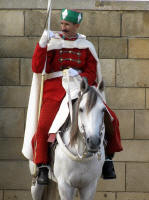
Monday 19 December 2011 to Sunday 1 January 2012, Meknes
Two weeks spent chilling out in the glorious sunny wind free weather started the feet itching again. We will now go ahead and obtain the visa for Mauritania and Mali.
We did do things though, such as visit the old and the new city, look for an inverter (unsuccessfully so far) and buy an internet modem.
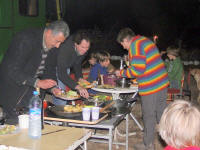
Christmas dinner was great. Five families came together. We all added something to the meal and enjoyed each others company until it became too cold. There was a Belgium family of 6 (Inge, Gud, Juttu, Freek, Suze, Liz), a Canadian couple (Alice and Kelly), an English couple (Wendyand Ian), a Spanish couple and of course us representing Holland, Australia and South Africa - quite a well traveled international group. Abdul, the camp owner was also invited. He is such a very nice person who speaks several languages. He brings us fresh bread and tea every morning and is always ready to help.
The three older women, myself, Alice and Wendy walked up to Sidi Ali one day. It is a kilometer up the road, and I mean up! Hard work but it brought us to a lovely little village where we did some essential shopping. Another day Wendy and I went into Meknes and visited the Dar Jamai museum. We both tend to go slowly and really look at the items on display. Perfect partners. There were lovely robes on display as well as jewelry and rooms furnished as they used to be. Photos of the exhibits were not allowed but we could take them of the architecture. It is beautiful with carved pillars, doorways and ceilings. We also had a look around the souk.
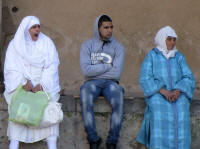
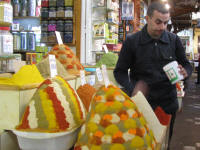
Bryan and Tracy turned up at the campground. We had met them in Layoune and clicked. We spent a lovely evening in their van talking about everything.
New Years Eve was spent with Wendy, Ian and Abdul. Abdul prepared a lovely meal with traditional soup, Harissa, a Tagine of mince balls and an egg in a sauce made with a mix of 24 spices, followed by fresh fruit salad and mint tea. He joined us to chat and share the wine. He also gave us a bottle of Cabernet Sauvignon. Such a lovely gesture.
Unfortunately the batteries gave out!!!!!! We will go to an auto electrician on the way out to see if it is the batteries themselves or just lack of charging. It reduced the number of times we could use the heater which was a real annoyance.
Second Intallment
Monday 2 to Wednesday 4 January 2012, Rabat
Our time was spent outside the embassy with nothing much to do except wait. It took 2 days to obtain the Mauritanian visa and another day for the Mali visa. This came very late in the afternoon. I discussed the security situation in Mali with the ambassador who assured me it was safe. There were many black Africans around so when Pieter left the steps one night, they were stolen. Welcome to black Africa!
After a reasonable journey the batteries are behaving. Pieter starts up every morning and runs the engine and heater to make sure. Nice to get up to a warm car.
Thursday 5 to Sunday 8 January 2012, Marrakech
We were so late leaving Rabat that we didn't get very far and decided to stop near the ocean. The beach guard invited us to spend the night in an abandoned property which was much nicer. We arrived in Marrakech next evening quite late but the camp ground was good and we did some household chores.
One evening we went into the main square in the old city, Djemaa el Fna. One side of the square is lined with small restaurants. The waiters all tout for customers. We only saw one that was full. When we finally chose a restaurant we were clapped by all the staff. Same happened to everyone else at every restaurant. The meal was lovely with olives, prawns, calamari and sausages. Sellers came by with trays of biscuits. We bought a selection and they were delicious. The square itself was full of various performers with huge circles of people all around several rows thick. I have no clue what they were doing because I would have had to really push and shove to get through to the front. It made for a fantastic evening.
We did see the Koutoubia minaret. This was completed at the end of the 12th century and set the classic Moroccan design with ceramic inlay near the top and different designs on different sides. Unfortunately the Saadinian Tombs were closed for the night. These were the two sights I wanted to see.
We also managed to fill up our gas bottles. Marrakech is one of the few places where this can be done in Morocco.
Monday 9 to Saturday 14 January 2012, to the border
We found a lovely campsite near Paradise Valley with a washing machine. What a pleasure.
Otherwise we have traveled this way before. We even remembered to stop at the stop sign on the circle in Tan Tan. It was quite windy and there were quite a few dust storms. In Dakhla we were surprised to see so many campers along the cliffs lining the peninsular. From Dakhla we gave a lift to a German man, Pieter, who was on his way to Mali. We thought it would take two days to the border but we were 100k away at lunch time and decided to cross the border the same day. The road is good and you can go quite fast. The only bad bit is the few kilometers between the border posts.
| Averages | Euro | ||||
| Cost per litre diesel | 0.59 | ||||
| Camping per night |
5.37 |
||||
| Hotels per night | n/a | Africa Menu | |||
| Kilometers traveled |
4,138 |
||||
| Days in the country | 72 | Home Page | |||